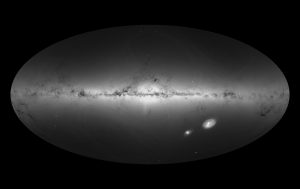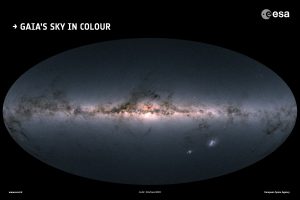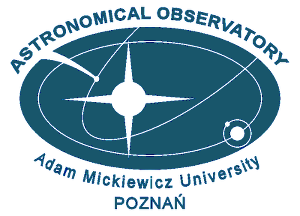The biggest and the most accurate up to now new map of our Galaxy – Milky Way – will be created thanks to the data gathered by the cosmic telescope Gaia. The release of the new catalogue (DR2) containing important data about positions, distances from Earth, and velocities for more than 1 billion stars took place on 27th of April. An important role in this project play Polish astronomers.

Credit: ESA/Gaia/DPAC
“The Gaia catalogue announced today will revolutionize astronomy. Tens of scientific papers wait for publication and this is possible thanks to the precise and vast Gaia data” – said Dr hab. Łukasz Wyrzykowski from Astronomical Observatory of the University of Warsaw.
Gaia is a sattelite of the European Space Agency (ESA) designed to perform precise astrometric measurements, was launched on 19th of December 2013 from French Guiana and started its 5-year mission in June 2014.
Almost half thousand scientists and software engineers are involved in data conversion from raw telemetric data into useful scientific measurments. They work witin Gaia Data Processing and Analysis Consortium (DPAC) and come from over 20 different European countries, including Poland, but also countries like Algieria, Brazil, Israel and Unitated States. The Polish contribution consists of the work of Dr. hab. Łukasz Wyrzykowski from Astronomical Observatory of the University of Warsaw who work on the search of supernovae and gravitational lensing of black holes, Dr. Arkadiusz Hypki who creates tools for data analysis, and Dr. Toni Santana-Ross who studies small bodies of the Solar System, both from Astronomical Observatory Institute of the Adam Mickiewicz University (AMU) in Poznań.
“The Gaia catalogue already has a large size. In the next few years it will be even bigger and eventually it will need over 1 petabyte of disk storage. It makes the astroinformatics become more and more important branch of astronomy” – commented Dr. Arkadiusz Hypki from the Astronomical Observatory AMU.

Credit: ESA/Gaia/DPAC
“Our current understanding of the Milky Way before Gaia DR2 is like walking in the wood with one eye opened. Although we see the trees, we have trobules to distinguish which ones are closer and which further away – it is easy to hit one of them. The Gaia DR2 adds, this very much needed, second eye. Now, we can see the distances to the stars. The Gaia sattelite uses actually the same phenomenon as the human’s eye – the parallax. The only difference is that the Gaia does this much more precise. In my work of studying the transient phenomenas, thanks to the distances provided by Gaia, it will be much easier to distinguis flash from the distant galaxy from the small flash in our Galaxy. The precise distances and proper motions will allow us to easier find single black holes which can work as gravitational lenses” – adds Dr. hab. Łukasz Wyrzykowski
The main goal of the Gaia observatory is to perform precise, three dimensional map of the Milky Way. By studying the exact structure of the Galactic disc, in which our Solar System is located, will be crucial for all upcomming astronomical observations. The Hertzsprung-Russell diagram which classifies the stars will become the most accurate up to day. By knowing the distances to stars from Earth it will be possible to accuratelly interprete the observational luminosities. The data from Gaia will allow also to study the groups of stars, e.g. star clusters, and also binary stars – even the wide ones for which the gravitational effects are already weak.
Contact:
Dr hab. Łukasz Wyrzykowski
Astronomical Observatory
University of Warsaw
Tel: +48 608 648 817
E-mail: lw@astrouw.edu.pl
Dr Arkadiusz Hypki
Astronomical Observatory Institute
A. Mickiewicz University
Tel: +48 692 256 450.
E-mail: ahypki@amu.edu.pl
References:
[1] Gaia sattelite is equipped with a CCD detector consisting of over one billion pixels and is used mainly to measure the movements and luminosities of over one billions stars of the Milky Way. Every star will be measured on average over 100 times, which will allow to find many variable stars and stars with some strange behaviour e.g. with stars with outbursts. [2] First release of the Gaia data mande by European Space Agency made in September 2016 contained the distances to about two millions of stars. Gaia is a successor of the another space mission Hipparcos, which gathered distances to about one hundred thousand of stars. [3] Dr hab. Łukasz Wyrzykowski is involved into the Gaia mission from 2008. In the years 2008-2015 he was working on the University of Cambridge on the preparations of a system to detect transient events, e.g. supernovas. He is also responsible for the organisation of the network of the ground based telescopes, which can be used to provide additional observations of the events detected by the Gaia mission. This work is done within the four-years pan-european program OPTICON, which supports the development of the european astronomy within the Horizon 2020 of the European Commission. The scientific research is also supported by the grants from the Polish Ministry of Science and Higher Education and National Science Center. [4] Dr Arkadiusz Hypki is adiunkt at the Adam Mickiewicz University in Poznan. He works on the dynamical and stellar evolution of star clusters. His role in the Gaia mission is to provide the tool for data analysis of large data sets. He is the developer of the BEANS software which provides an alternative way for the analysis of the Gaia data in order to compare them with e.g. numerical simulations. His work is supported by the grant from the National Science Center.source: Astronomical Observatory University of Warsaw | 2018\04\25

